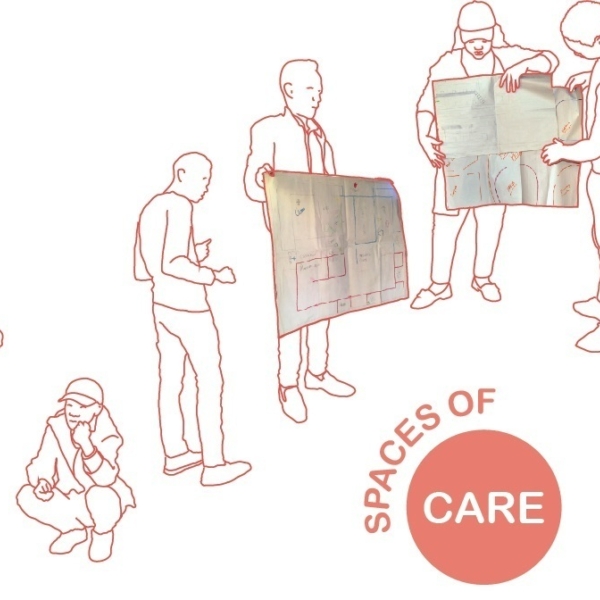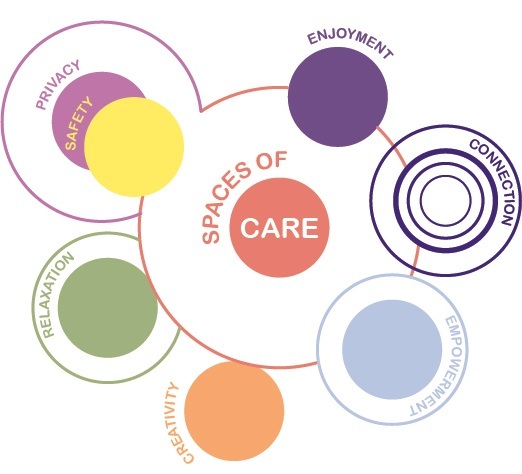
Spaces of Care
These ideas formed a proposal we called ‘Spaces of Care’. Adolescents living with HIV in urban South Africa rely on a multitude of people, spaces, environments, objects for their care and wellness. Taking a systems and design thinking approach, thinking beyond conventional medical conceptions of healthcare, we are framing all these relationships and interactions as spaces and systems of care.
Published on Sep 06, 2019
Spaces of Care
These ideas formed a proposal we called ‘Spaces of Care’. Adolescents living with HIV in urban South Africa rely on a multitude of people, spaces, environments, objects for their care and wellness. Taking a systems and design thinking approach, thinking beyond conventional medical conceptions of healthcare, we are framing all these relationships and interactions as spaces and systems of care.
Published on Sep 06, 2019

Khuluma Spaces
I’d like to preface this piece by thanking and acknowledging the Khuluma mentors whose insights I’ve tried to capture here. This research reflects their knowledge, creativity and strength, these actions in the themselves cultivating a space of care.
I first encountered the Khuluma project during the 6 voices workshops in December 2018, where we gathered a multi-disciplinary team to interpret some of the Khuluma messages. For me, the most powerful part of the workshop was hearing from the mentors, describing their experience of the groups and what they’ve learned from it. They described Khuluma as a kind of home. Hearing this made me consider the spatial aspects of the care they were giving and receiving through the group: how does a digital or virtual space such as the Khuluma messaging interface interact with the physical environment? How is sense of a safe space created through using the service? And what it might offer that physical spaces of care - within clinics, support groups and homes - are lacking?
These ideas formed a proposal we called ‘Spaces of Care’. Adolescents living with HIV in urban South Africa rely on a multitude of people, spaces, environments, objects for their care and wellness. Taking a systems and design thinking approach, thinking beyond conventional medical conceptions of healthcare, we are framing all these relationships and interactions as spaces and systems of care.
This is based on an idea that in order to deliver ‘good care’, we need to understand a total picture of someone’s health and wellbeing. For the Khuluma mentors, this is important for two reasons:
- Firstly, being an adolescent is complicated. It’s an age where independence and privacy become important, responsibilities and expectations grow, but at the same time most adolescents are still young and need support.
- Secondly, living with a chronic condition is difficult, and the experience of managing it is so much more than good medical care. In the case of HIV, this can be even more complicated due to the stigma around the conditions that remains high in South Africa particularly.
So how can we develop an understanding of the adolescent experience of living with HIV, and a broader picture of their health and wellbeing?
To uncover and cultivate these ideas, it was important for me to learn from the mentors. In June 2019 I travelled to Pretoria to spend a week working with the mentors with participatory workshops mapping their daily routines and environments and understanding their experiences of health and care through walking journeys and group discussions.

A key part of the approach of both Stema and the SHM Foundation is working upwards from the grassroots, those who are directly experiencing certain challenges have unique insights that can create what we could call the most careful solutions. With this in mind, for me, the Khuluma mentors sit at the centre of a system of care, they are to a large extent managing their own care. For anyone experiencing illness, or needing care; it is not one place, one person, one medication that will provide the sense of support they might need. Rather there is a system of spaces, people, and objects that interact and form a system of care; which may or may not be providing the care needed.
One of the key findings of the ‘Spaces of Care’ research has been that while health is physical state, care is an action and a process of exchange. Communication, trust and respect are key aspects of caring. One of the mentors described care as: “being able to take responsibility for yourself […] something you learn for yourself.” I think this quote illustrates how the mentors are strong and resilient, taking their care into their own hands. They understand the links between physical and mental health, and the importance of taking action to maintain a sense of care with how you engage with the world, describing caring for your physical body, for others through relationships and for non-human things such as a garden or your phone that allows you to connect with others.
[speaking about the home]
“I love this house because there is love, peace, harmony… the things I love. That is my free space.”
We found that the spaces most important for the adolescent’s health and wellbeing were: the home, where they felt safe and supported; places they could connect with others, such as the mall, or park where they can access wifi; places they could look after themselves, such as the school for learning or gym for fitness; and places they could be creative, which varied between individuals. We formulated ideas about what different spaces of care might be, and these include: spaces of connection, spaces of privacy and safety, spaces of creativity, spaces of empowerment, among others. These ideas break away from understanding space as physical, and focus on how a space can be used, the emotions it might invoke and gives room for physical spaces to be co-opted in different ways.

We are developing ideas about what a holistic system of care for adolescents might look like, in order to understand how Khuluma can evolve and continue to provide much needed support to an under-resourced health service.
The commitment and energy of the mentors in Khuluma is inspirational, Khuluma itself is developing into an evolving system where the mentors are gaining valuable skills to take the next steps in their lives, and has opened them up to giving back and caring for others. One of the mentors described how now when they went to the hospital, they felt more able to engage with others and were able to convey a sense of empathy in their actions.
Mikaela Patrick is an architectural designer and researcher with Stema Health System Innovation. Her work takes a people-centred approach to exploring the relationships of architecture, health and the environment and she is particularly interested in developing ideas about systems of care in relation to people’s and planetary health.
Published: 6 September 2019

Contact Us

Have a challenge you think we could help with? A project you'd like us to collaborate on?
Just want to say hi? Reach out - we love meeting new people